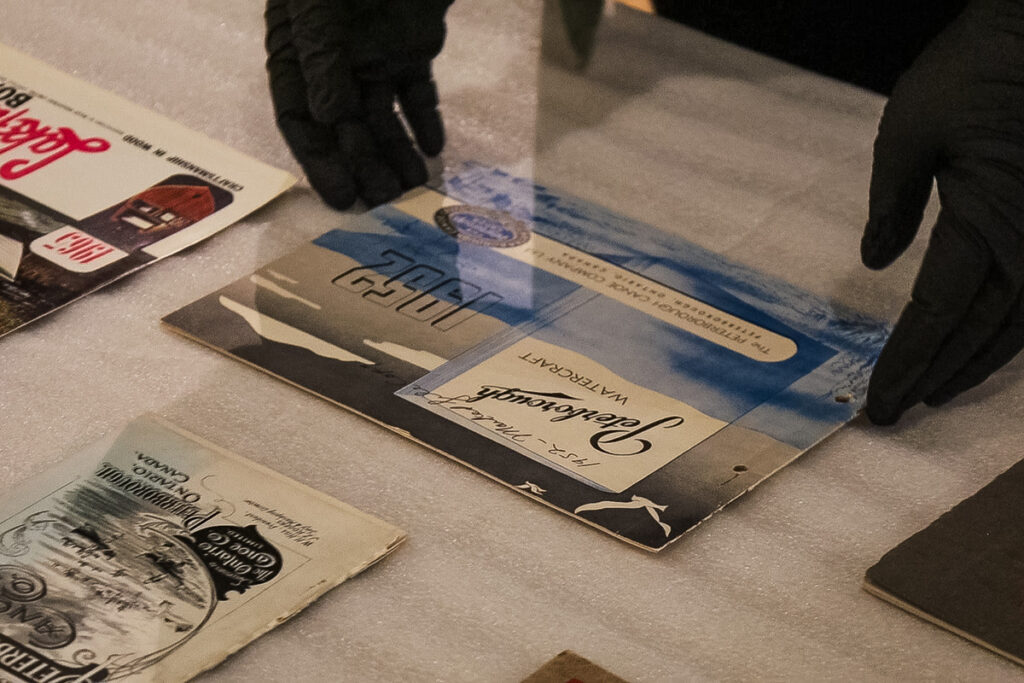The Collection
Founded on the collection of the late Professor Kirk Wipper and established in Peterborough, Ontario, in 1997, The Canadian Canoe Museum cares for more than 600 canoes, kayaks and paddled watercraft, with over 100 on display in our Exhibition Hall. Together, they span the country from coast to coast to coast, representing many of the major watercraft traditions of this country and even the world.
Not just a collection of watercraft, the Museum also stewards a collection of paddles and paddling accessories, small artifacts including canoe and kayak models, an archival collection that includes photos, postcards and canoe manufacturing history, and a reference library and a rare books collection.
This unique collection is as diverse as the people, stories, and makers behind the watercraft! In 2013, the Senate declared The Canadian Canoe Museum and its collection a cultural asset of national significance.
The Collection Hall is a breathtaking centerpiece of the Museum, spanning 20,000 square-feet and housing over 500 watercraft not on display in the Exhibition Hall. This impressive space is dedicated solely to caring for these watercraft and sharing more of the collection for generations to come.
Our new Collection Hall enables:
- Integrated, On-Site Storage: Providing 20,000 square feet of seamlessly integrated and accessible storage space for the collection.
- Inspiring Visibility: Drawing in visitors with a captivating view from the Atrium and Mezzanine through magnificent 23-foot high glass windows, inviting everyone to witness the diversity and depth of the collection.
- Enhanced Artifact Care and Stewardship: The Collection Hall will care for the collection with Class “A” Museum Environmental Control standards, nurturing these artifacts with the utmost respect.
- Honouring of Cultural Practices: Embracing traditional care practices, the Collection Hall sets a precedent for the rest of the Museum in accommodating practices like smudging ceremonies and fostering an inclusive and respectful environment.
- Open Doors, Shared Stories: For the first time, the collection will be available to view via tours and appointments, facilitating increased engagements, connections, and understanding.
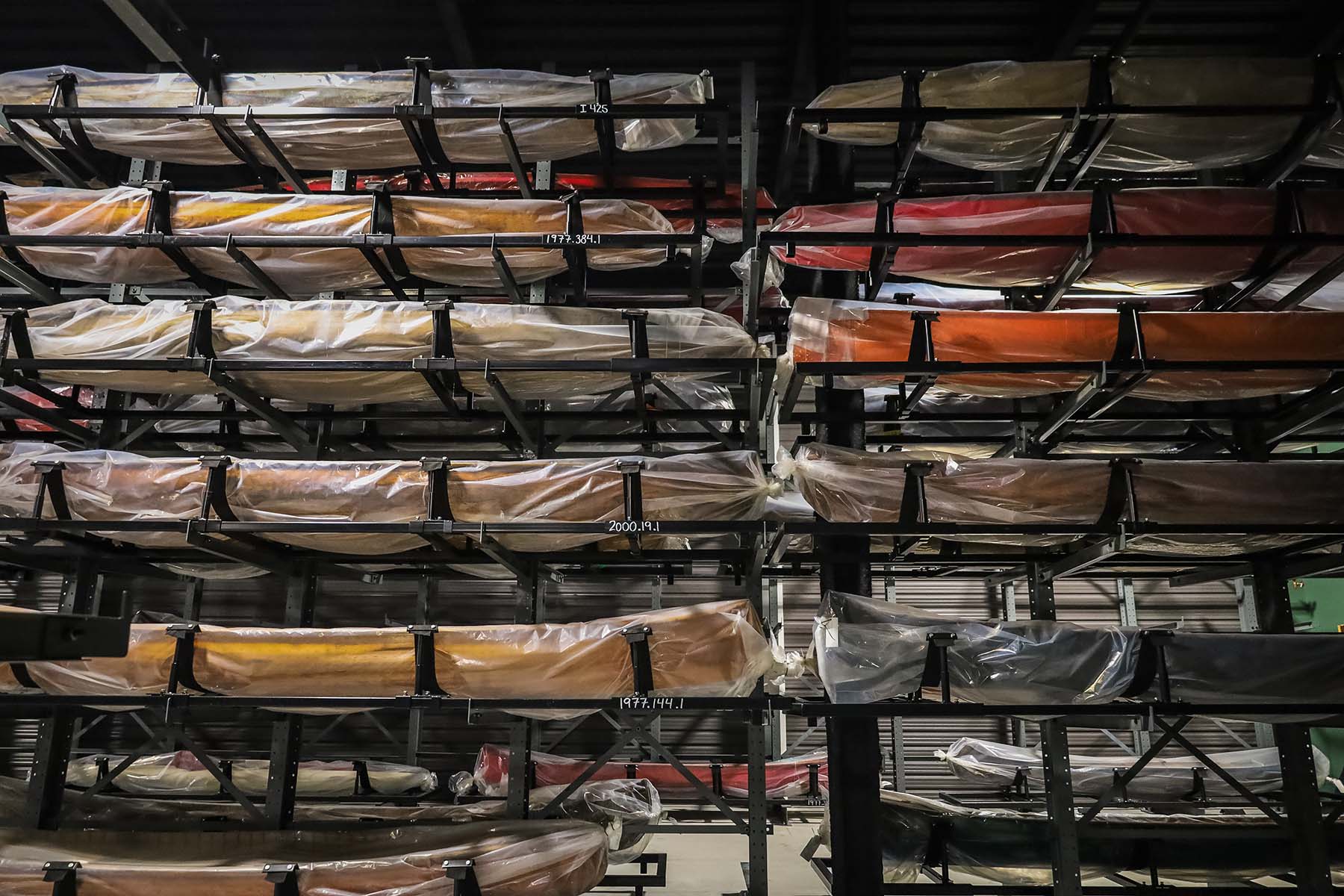
Donate an Artifact
Donate an artifact to The Canadian Canoe Museum and help us share the incredibly diverse stories and legacy of paddled watercraft.
Learn more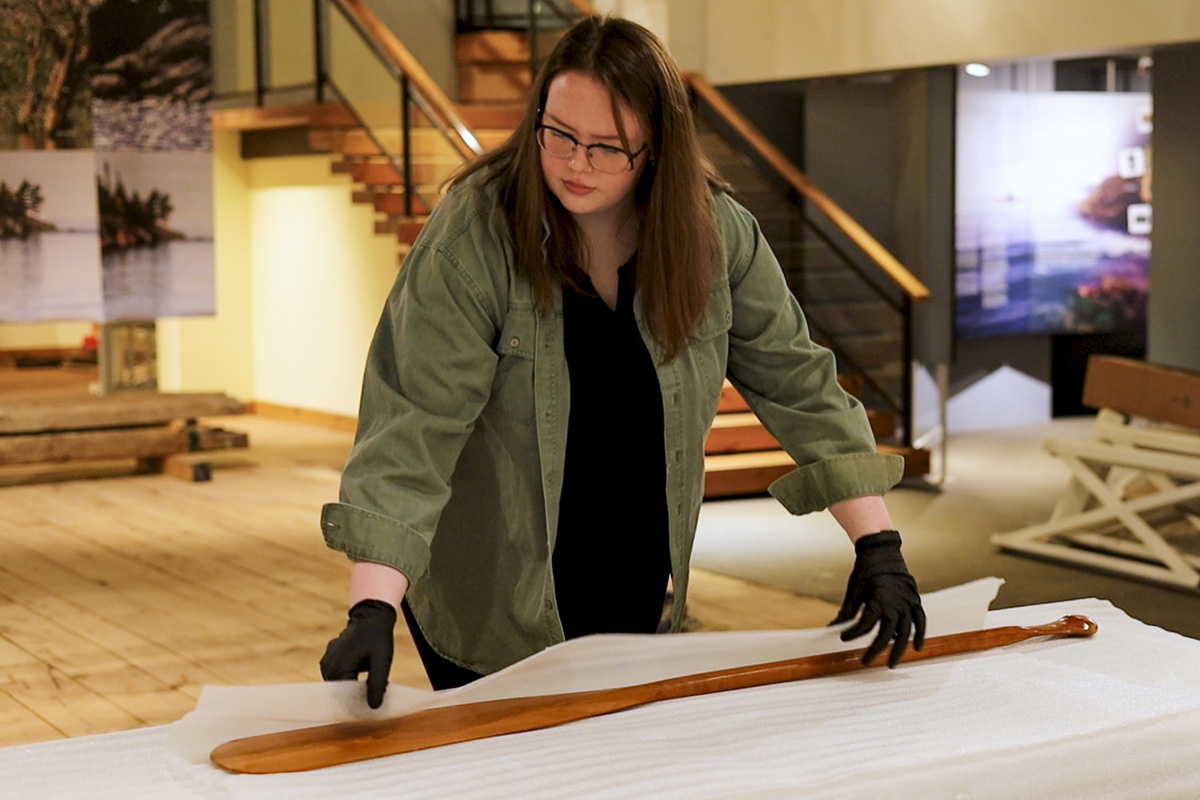
Deaccessions & Repatriations
The collection is carefully curated to ensure alignment with our values and mission. Learn about the process for deaccessioning or repatriating artifacts.
Learn moreWelcome to the Collection Hall
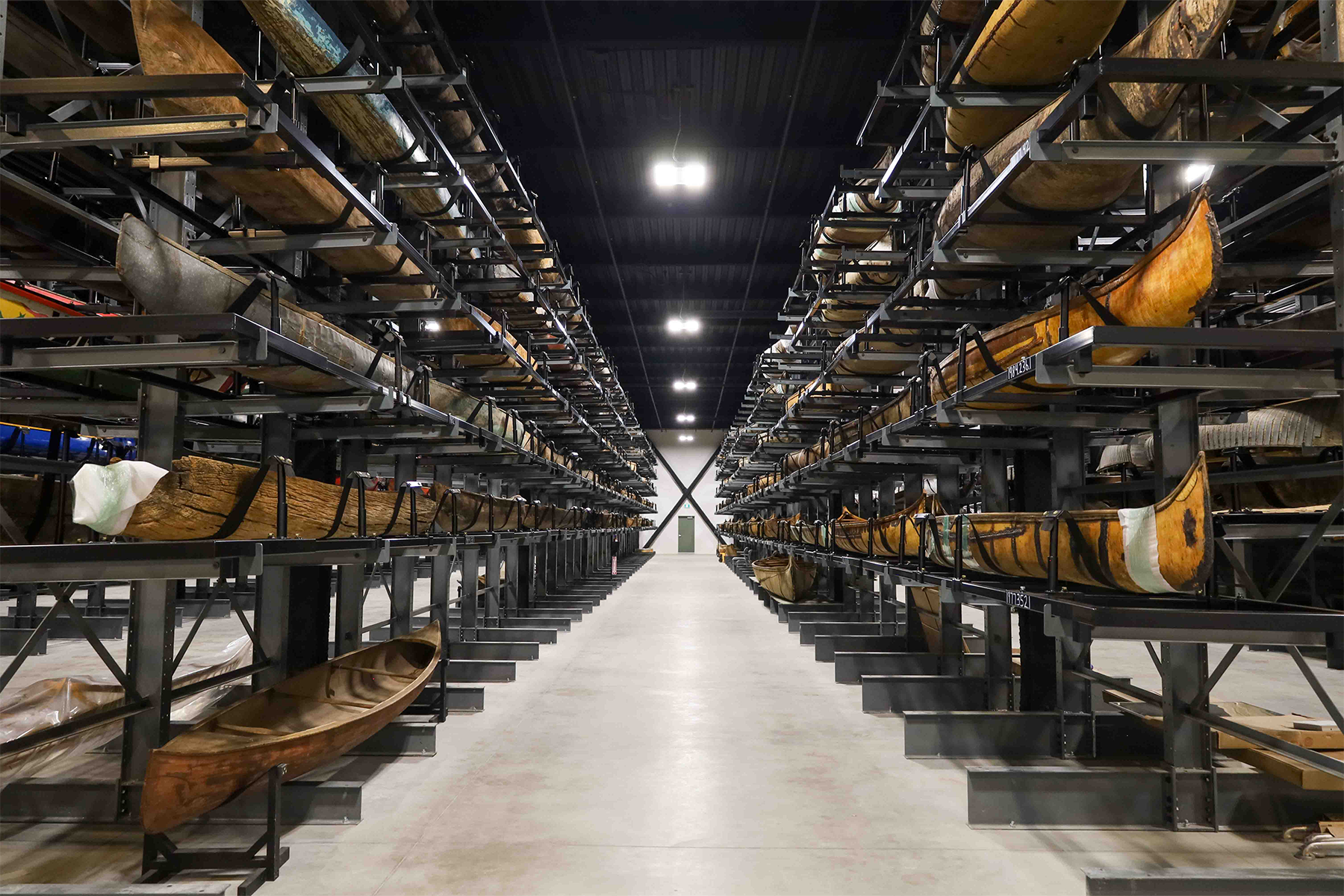
In the Collection Hall, watercraft are stacked six vessels high on custom-built cradles and arranged by construction type. This approach also reveals the rich diversity of design, materials, and techniques used to craft these paddled watercraft. It also allows visitors to grasp the artistry and the sheer scope of this unique collection! Take a peek through the glass doors, from the windows on the Mezzanine, or join us for a Collection Hall tour to go behind-the-scenes.
Below, you can learn about the six distinct construction types represented in the Collection Hall: wood and canvas, all wood, bark, dugout, composite, and skin on frame. Each method offers insight into the cultures, environments, artists, and innovations that shaped these remarkable watercraft.
Explore the Different Canoe and Kayak Construction Types
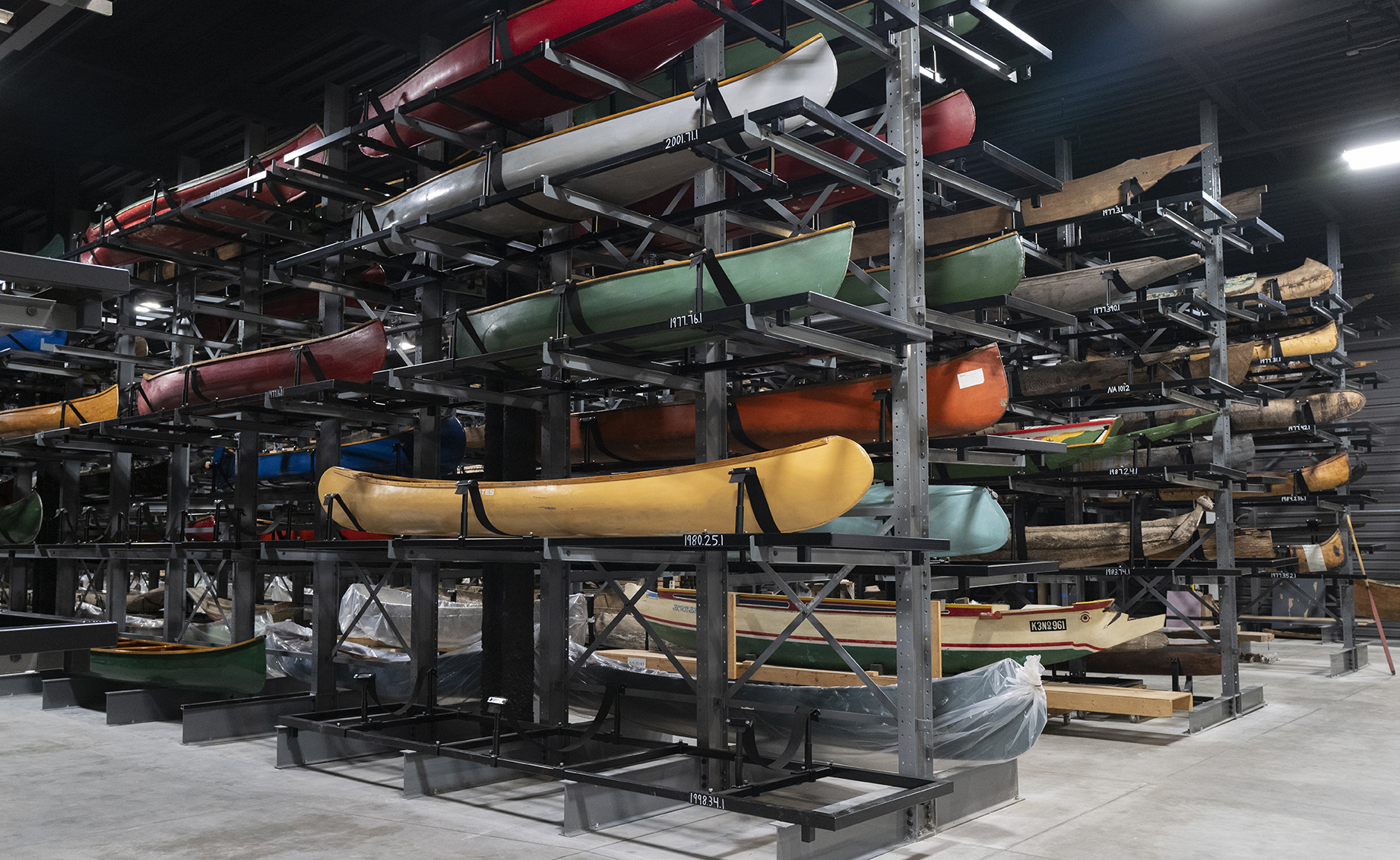
WOOD AND CANVAS
A classic combination of a wooden frame and tightly stretched canvas.
LEARN MORE
- A Time-Honoured Craft: The wood and canvas canoe is one of the largest groupings in the collection, showcasing a tradition of craftsmanship found in many parts of Canada and the US.
- Enduring Legacy: These iconic canoes continue to be crafted today, and the museum’s collection celebrates this historic and evolving technique.
- Unique Construction: Cedar canvas canoes feature a cloth layer stretched over the wooden hull and made waterproof, unlike most other factory-built methods.
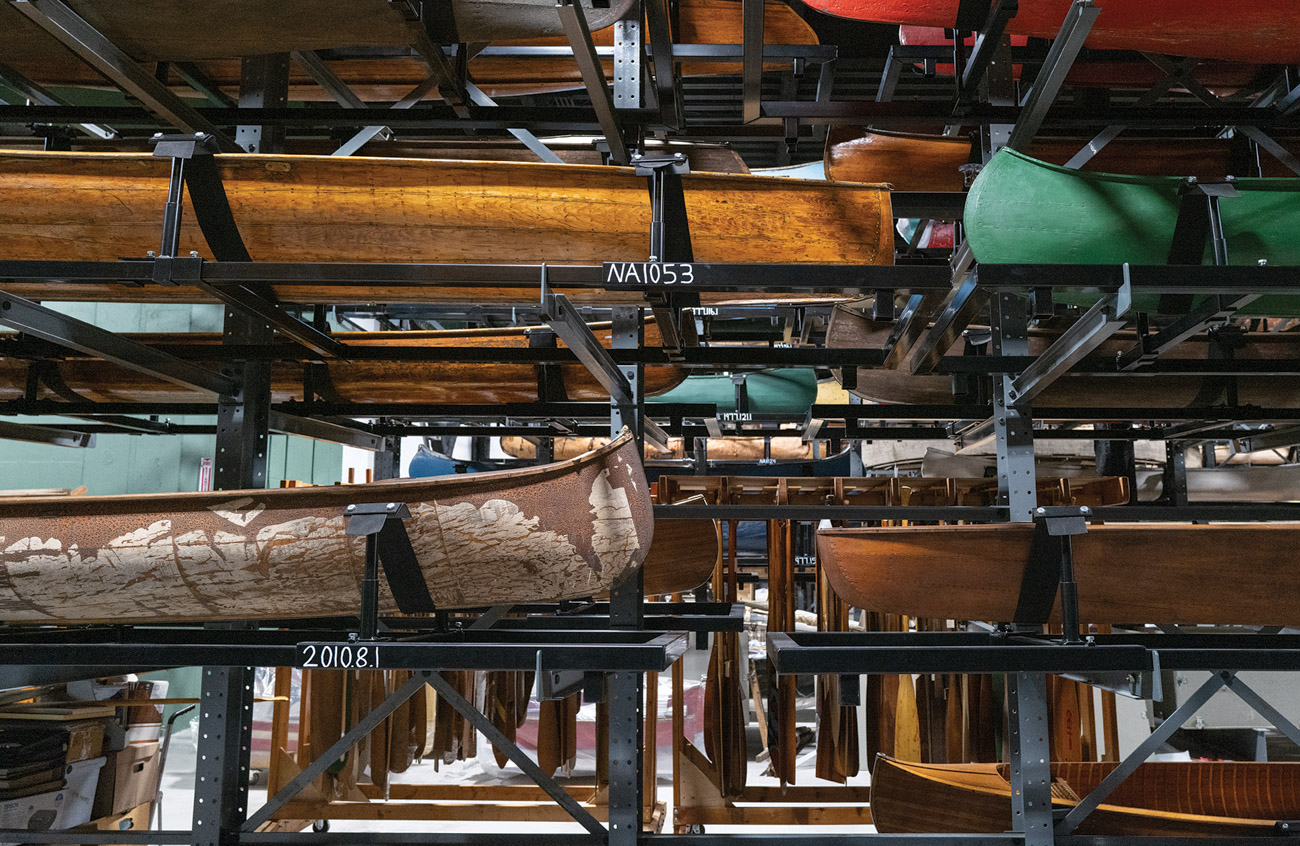
ALL WOOD
Traditional canoes crafted entirely from wood.
LEARN MORE
- Celebration of Locally Manufactured Canoes: Peterborough was once a world-renowned hub for canoe manufacturing, and this collection features watercraft produced in the river valley between Lakefield through Peterborough to Rice Lake, celebrating the legacy of locally and nationally manufactured canoes.
- Early Factory Production: Featuring some of the earliest examples of workshop and factory-built canoes, there is a wide range of patented building methods represented in the all wood collection, including “board and batten”, “cedar strip”, “cedar rib” and “Herald’s Patent”.
- Woodworking Heritage: These canoes showcase the amazing diversity of innovations and joinery techniques used in building lightweight, watertight watercraft, all without a waterproof covering.
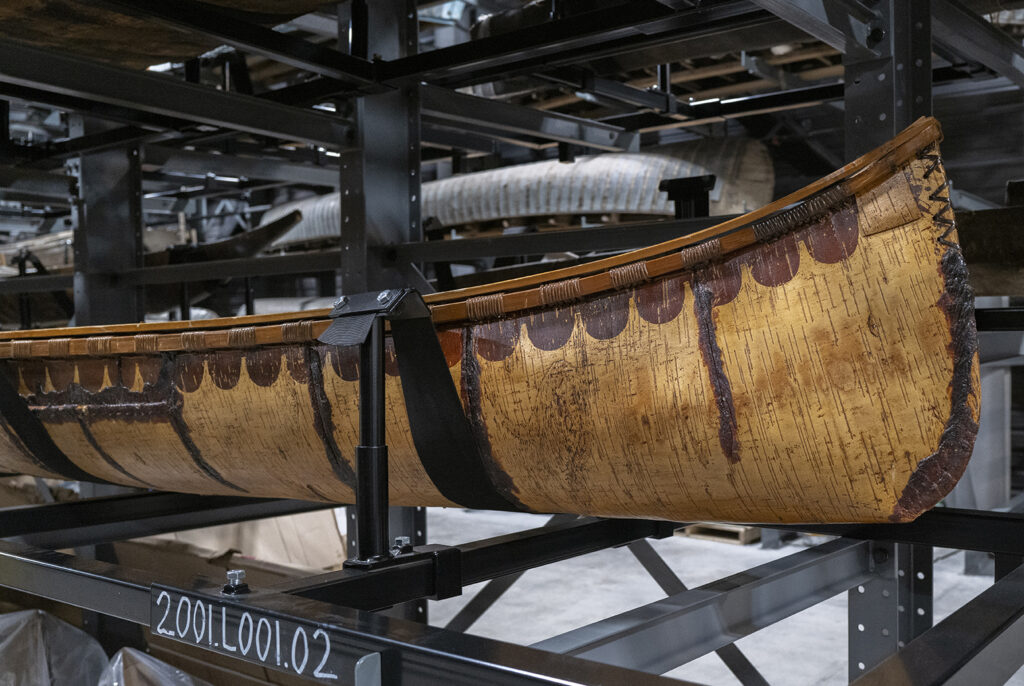
BARK
Historic vessels created from bark, honouring Indigenous methods.
LEARN MORE
- Bark Canoe Cultures: This grouping reflects bark canoe-building traditions that span the woodland region from the coastline of the Atlantic to the Northwest Territories.
- Amphibious Design: Bark canoes are an ideal means of travel across water and portage. The lightweight bark hull is tailored to shape and supported by the pressure of the added wooden framework. Seams in the bark are typically sealed with a tree resin compound to ensure they are watertight, making them seaworthy for local waters and long-distance journeys.
- A Diverse Reflection of Heritage: The variety in shape and design of each bark canoe reflects its intended purpose as well as the cultural traditions and signature details of the makers.
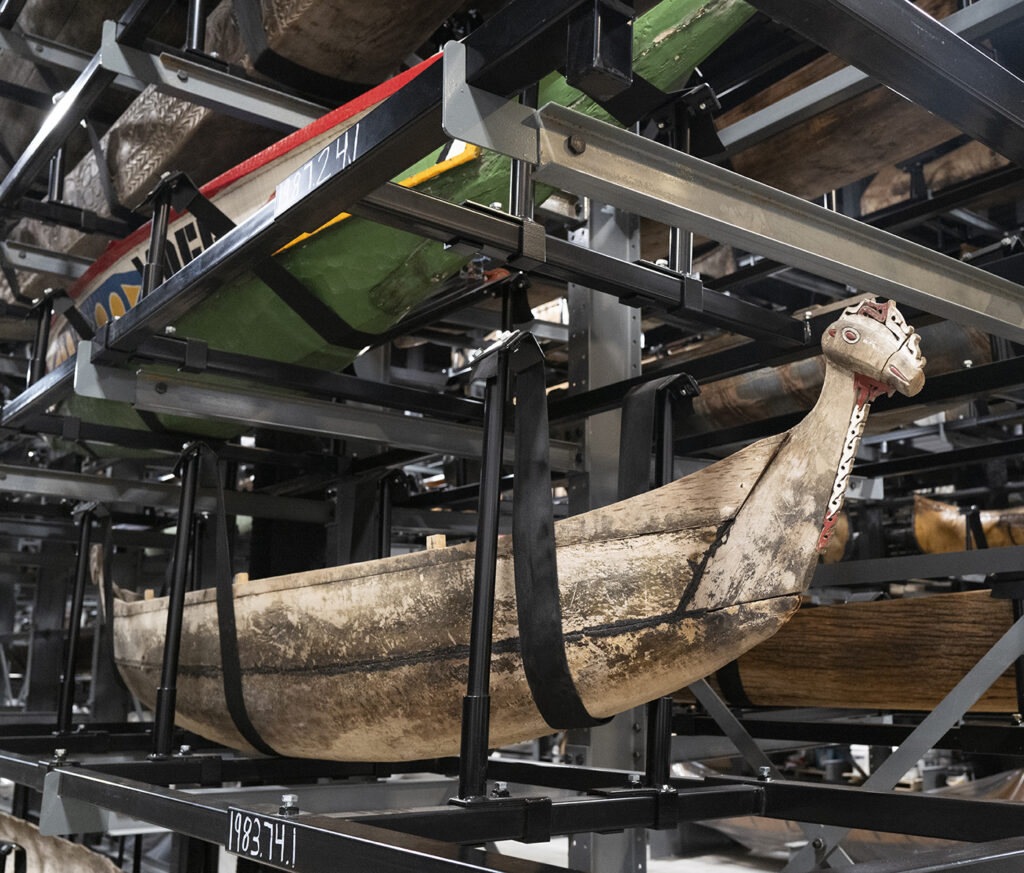
DUGOUT
Canoes carved from a single log.
LEARN MORE
- Ancient and Global Tradition: Dugout canoes, shaped from hollowed logs, are made and used in the Americas and many cultures worldwide.
- Skilled Carving Techniques: Using a section of log for the basis of the hull, the makers first establish the outer shape of the dugout canoes and then hollow out the hull to the desired thicknesses.
- Global Adaptations: In the Pacific Northwest, carved dugouts are also steamed and spread to flare their sides; in other regions, they are equipped with outriggers or paired with another hull to allow coastal or even ocean travel.
- A Legacy of Ingenuity: These canoes embody resourcefulness and the deep connection between builders and their waterways.
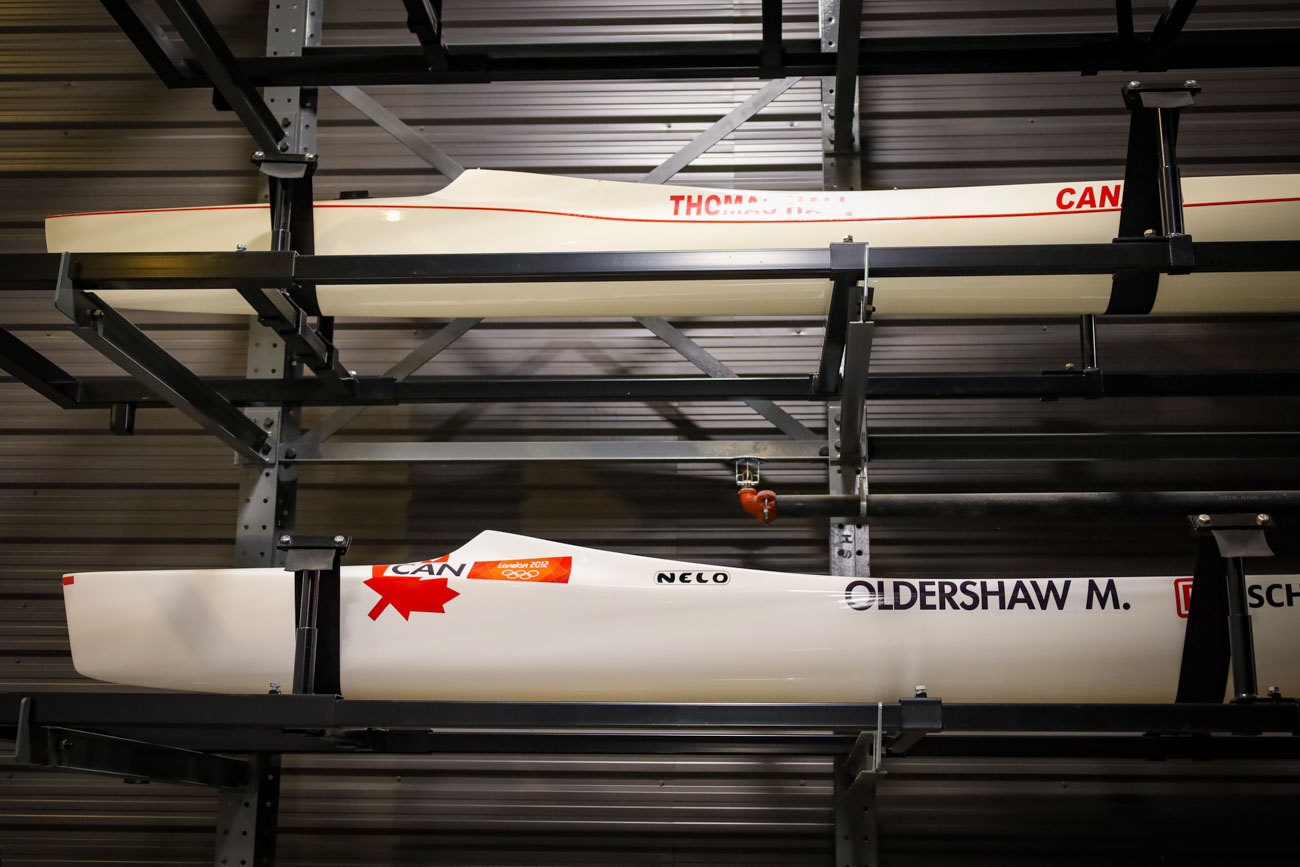
COMPOSITE
Innovative canoes built with fiberglass or other lightweight materials.
LEARN MORE
- A Diverse Collection of Innovation: The most diverse grouping within the museum’s collection, the composites predominantly feature many versions of cloth-resin technology including Micarta (an early composite resembling fibreglass using linen and resins), Kevlar, and carbon fiber. Also included in this group are watercraft made from concrete by young engineers at competitions, canoes made of bundled Totora reed from Peru, molded veneers, and aluminum watercraft made by aircraft manufacturers.
- From Wartime to Peacetime: Many of these construction technologies and methods were developed or refined during wartime, but later found commercial application in canoe building during peacetime.
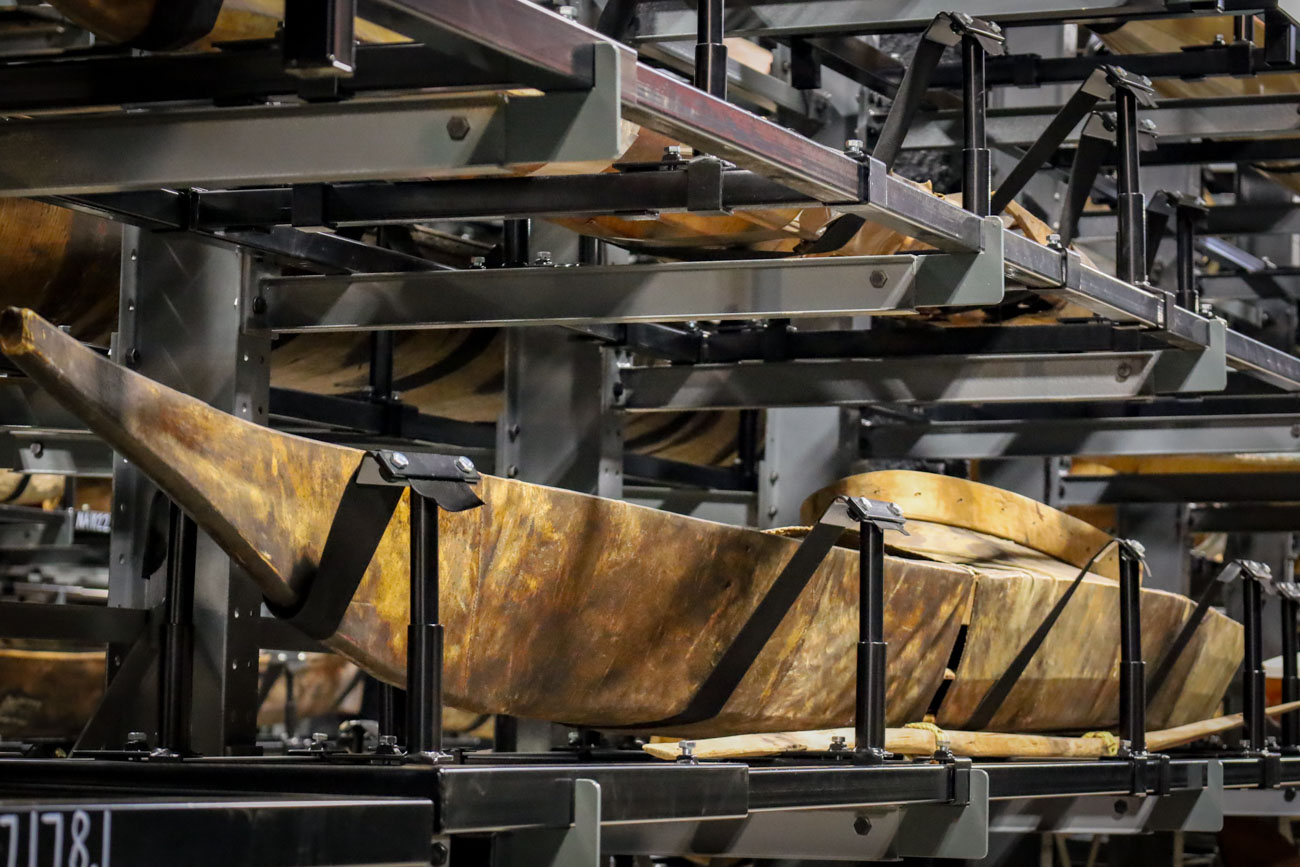
SKIN ON FRAME
An ancient technique using a frame covered with fabric or skin
LEARN MORE
- Watercraft Cultures Across the Arctic: The kayaks and umiaks of northern peoples, ranging from Siberia and across the North American Arctic to Greenland, are made from available wood materials (often including driftwood) and covered with animal skins. These scraped hides are sewn together with waterproof stitching and stretched tightly around the hull.
- Versatile Design: This method of boat building is also used for other types of watercraft including Mandan bull boats, Welsh coracles, and folding canoes and kayaks popular in Europe.
More Than Watercraft
In addition to our renowned watercraft collection, we also care for a remarkable collection of small artifacts, including a significant number of small-scale models, patterned after full-size canoes and kayaks, and more than 550 paddles!

CANOE AND KAYAK MODELS
Small-scale representations reflecting Indigenous traditions and factory-built replicas.
LEARN MORE
- Reflecting Indigenous Traditions: Many of these models reflect Indigenous traditions and techniques from across the continent and around the world. Their miniature hulls have been created with sealskin stretched over a lashed frame, carved from solid wood or stitched birchbark lined with ribs and planking—mirroring exactly the maker’s techniques used in building full-sized watercraft.
- Factory-Built Replicas: The model collection also features exquisite factory-made miniature canoes and kayaks made in factory settings by renowned manufacturers to proudly reflect the construction methods, fine details, and proportions of their offerings.
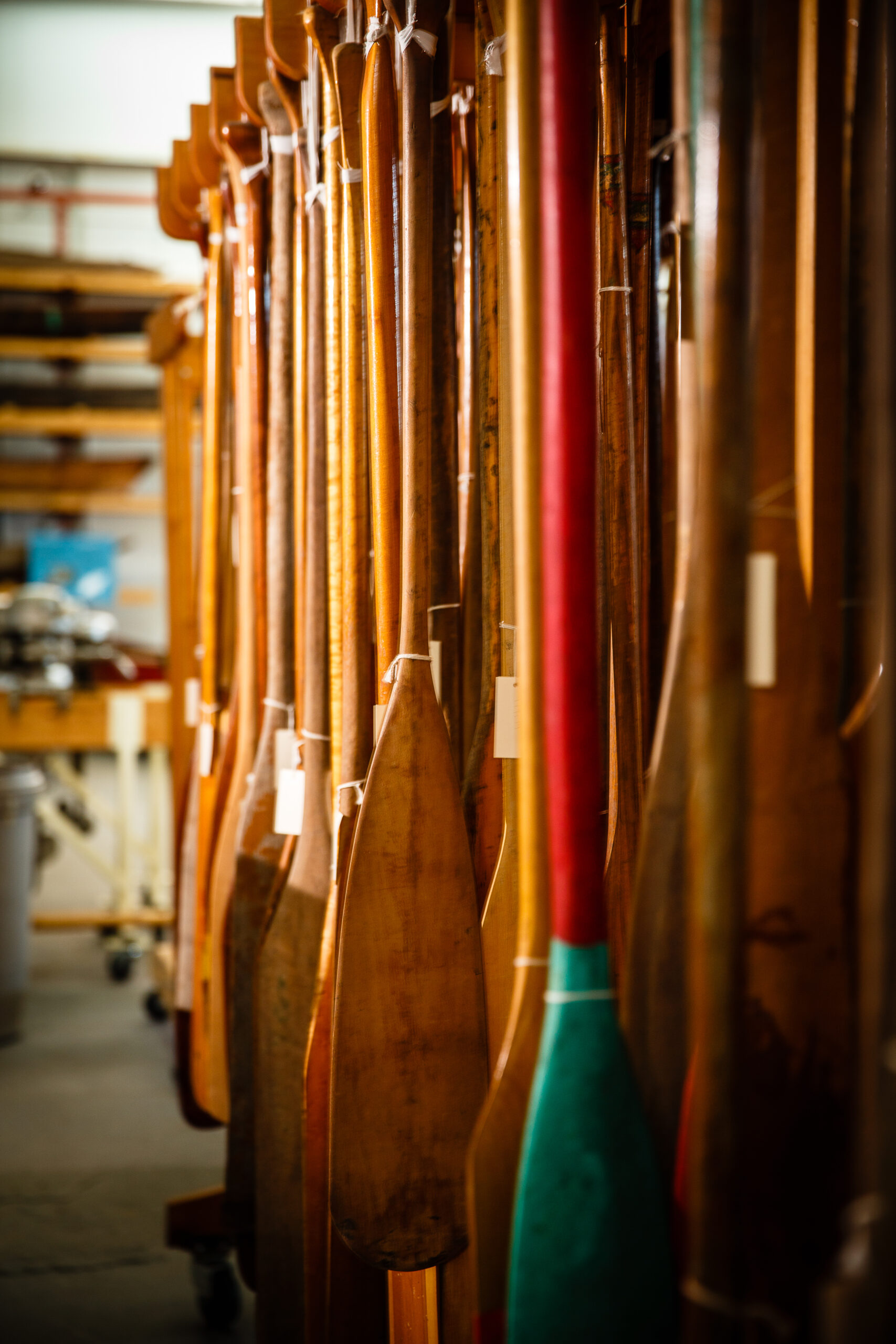
PADDLES
Over 550 paddles that are diverse in shape, size, and materials – many were used to propel specific watercraft in the collection.
LEARN MORE
- Function and Artistry: Each paddle’s blade shape, grip, and features reflect the functional needs they were designed to perform, as well as the aesthetics of the traditions they come from.
- Plain and Ornate: While some paddles are simple and functional, others are richly decorated, highlighting the craftsmanship, function and tastes of their makers and their intended users.
Collection Preview
Haida Dugout by Victor Adams (1977.1.1)
This Haida dugout was commissioned in 1967. It was built by Victor Adams at Masset on Haida Gwaii from a single cedar log. No such canoe had been built within living memory, and Adams was mentored by Adam Bell, an Elder. Construction took three years and was completed in 1971, along with paddles and a bailer. The canoe, painted black, was decorated by Adams and his daughter, Alice Montjoy, with an eagle design at the bow of the canoe. The canoe arrived at Ontario Place in Toronto in 1972, and after a ceremonial welcome, a group of campers paddled through the Trent-Canal system to Camp Kandalore. The building of this canoe preceded the remarkable resurgence of Haida canoe-building tradition. To quote Victor Adams, “It was a hard job, but I liked the result.” His son and grandson are now building traditional Haida canoes.
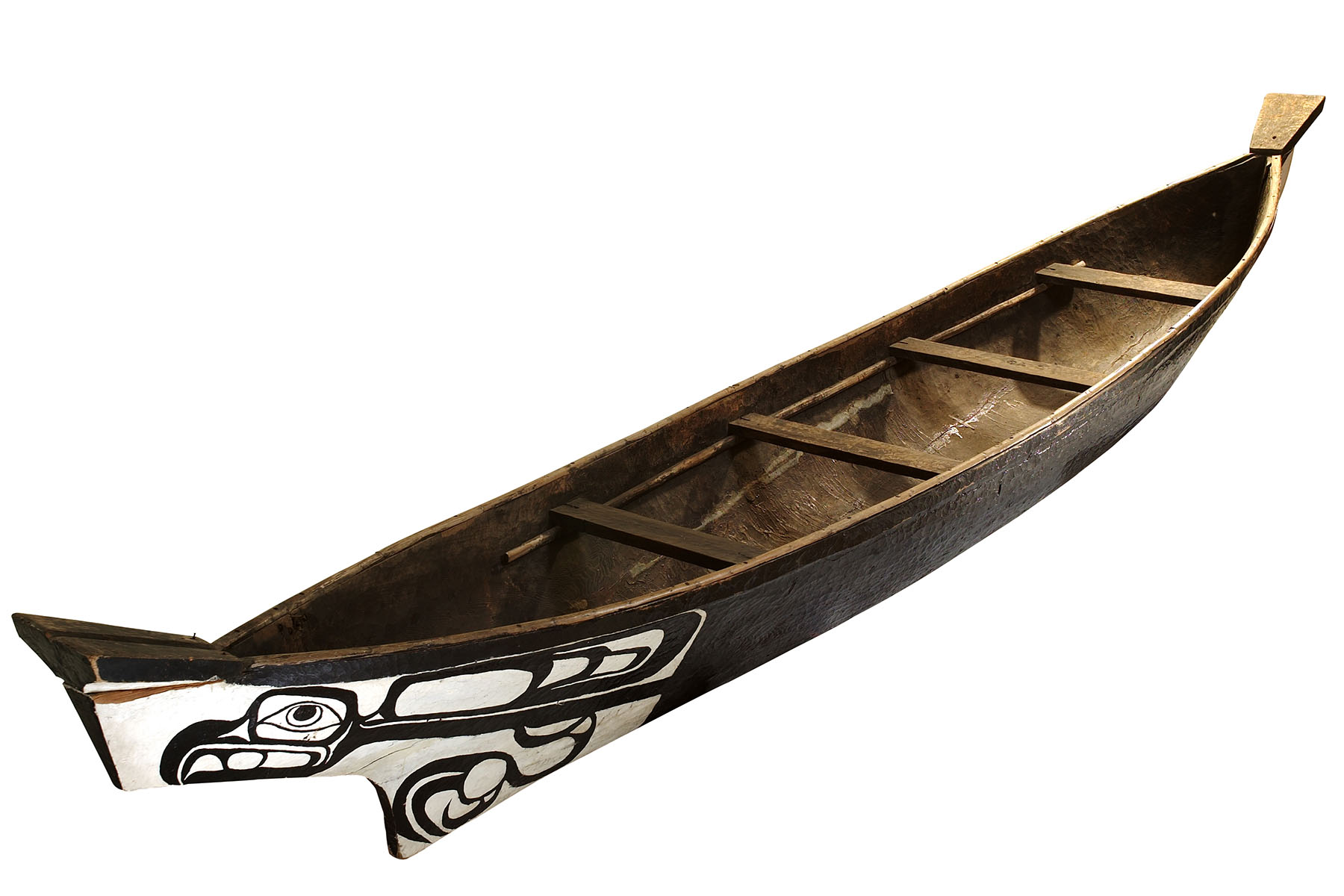
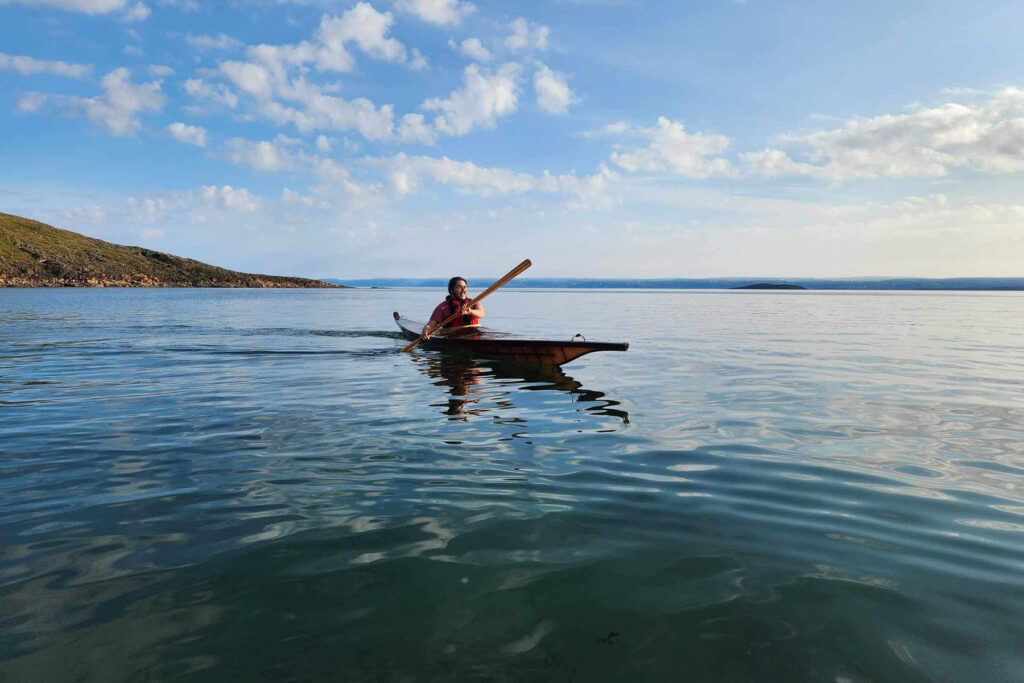
Uqqurmiut Qajaq (Kayak) (2023.4.1)
This qajaq (kayak) was built in 2023 for the Canadian Canoe Museum by the Qajakkut Society in collaboration with local Elders and knowledge holders in Iqaluit. This Uqqurmiut (People of Southern Baffin Island) qajaq is one of a handful built in recent years in Iqaluit. This qajaq represents a new generation’s interpretation of their own regional style.
Bill Mason’s Prospector (1999.16.1)
Bill Mason’s 16-foot red Prospector canoe is possibly the most famous canoe in Canada. It arrived at the Mason home on Meech Lake, north of Ottawa, from the builder, Chestnut Canoe Company in Fredericton, New Brunswick, in the spring of 1973. From that moment, the canoe was used in many of Bill Mason’s projects, his instructional films on canoeing, his books, The Path of the Paddle, The Song of the Paddle, and his last epic film, Waterwalker. It was frequently used on Bill’s month-long solo trips on the north shore of Lake Superior, on family trips in Algonquin Park, and on trips down the Pukaskwa River, north of Superior, where the canoe ribs were damaged. Bill danced at his son’s wedding with the canoe on his shoulders, and his wife, Joyce, scattered Bill’s ashes from it in 1989. It was donated to the Canadian Canoe Museum after their daughter, Becky, performed a canoe ballet on the Trent-Severn Waterway in Peterborough in 1999.
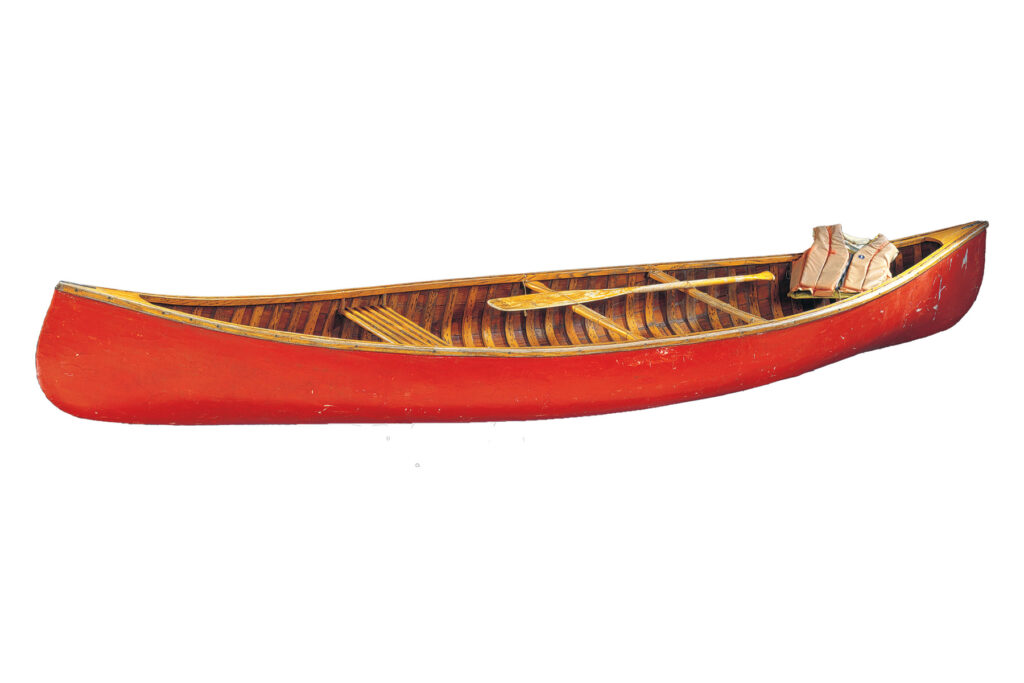
Photo Credit: Michael Cullen
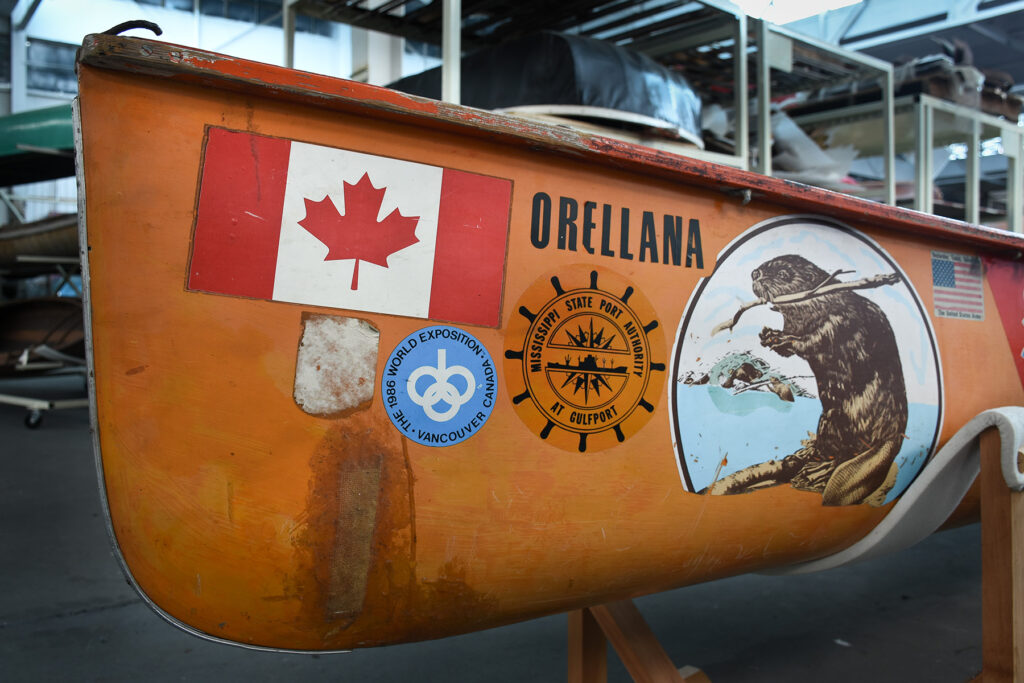
Photo Credit: Margo Pfeiff
The Orellana (2002.5.1)
The Orellana, a battered fibreglass canoe covered with decals, was recognized in the Guinness Book of Records in 1986 for the longest canoe journey – 12,000 miles. In this canoe, Don Starkell set out from Winnipeg, Manitoba, with his sons, Dana, and for part of the trip, Jeff. Beginning with upstream travel on the Red River, they reached the Mississippi and the Gulf of Mexico. Travel along the coast of Mexico was fraught with danger from ocean currents and surf landings, to which were added soldiers and bandits along the coast of Honduras and Columbia. After much-needed professional repairs in Venezuela, they reached the Orinoco River, where 1000 miles of upstream paddling connected them with the Rio Negro and the Amazon, finishing at Belem at the mouth of the Amazon.
Indigenous Collections
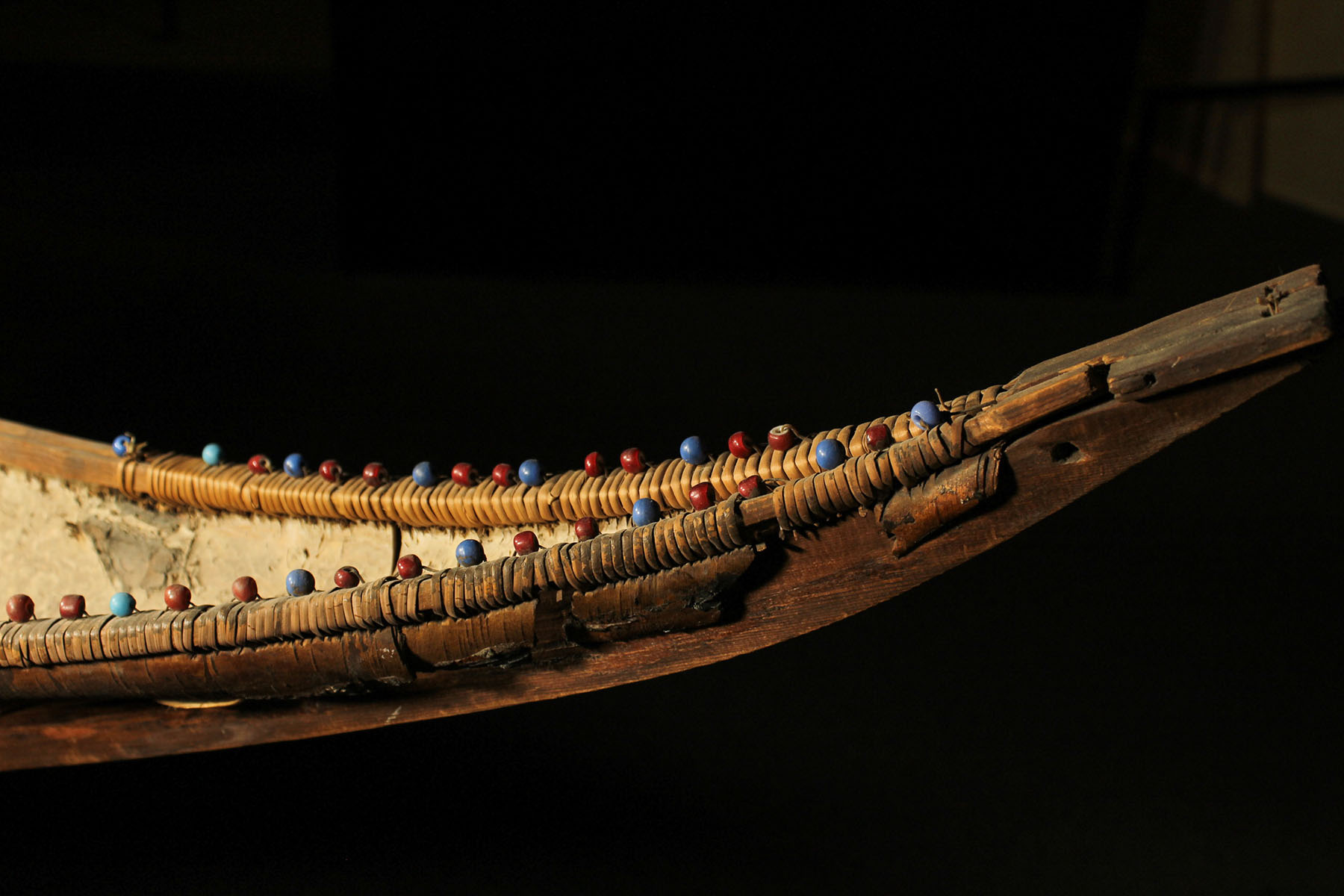
The Canadian Canoe Museum cares for over 600 watercraft, primarily from North America but also from around the world. The collection spans across cultures, both Indigenous and non-Indigenous, and represents a rich diversity of stories and histories. While the history of Indigenous collections in museums remains controversial, The Canadian Canoe Museum supports and prioritizes the accessibility of collections and cultural belongings to Indigenous Peoples.
Access to Collections
In 2022, the Canadian Museums Association released new standards for implementing the United Nations Declaration on the Rights of Indigenous Peoples (UNDRIP) and supporting Indigenous self-determination in museums. This includes “The recognition that Indigenous Peoples have intellectual sovereignty over all material created by or about them. This includes the right to know about these belongings and connected traditional knowledge or intangible heritage, as well as the right to control access to these.” It also recognizes “Indigenous Peoples as rights holders when it comes to accessing and stewarding their belongings. This requires co-development of methods of access and care of belongings that are defined by the Indigenous communities themselves. This may mean repatriation or stewardship.”
The Canadian Canoe Museum is committed to providing Indigenous rightsholders access to their cultural belongings through onsite, accessible collections storage.
United Nations Declaration on the Rights of Indigenous Peoples (UNDRIP)
The United Nations Declaration on the Rights of Indigenous Peoples (UNDRIP) is a comprehensive international instrument on the rights of Indigenous Peoples. It establishes a universal framework of minimum standards for the survival, dignity and well-being of the Indigenous Peoples of the world. It also elaborates on existing human rights standards and fundamental freedoms as they apply to the specific situation of Indigenous Peoples.
UNDRIP is the principal framework upon which the Truth and Reconciliation Commission’s (TRC) Calls to Action are based. The Calls to Action by the TRC are aimed at a range of institutions, laws, and programs affecting Indigenous Peoples and legislation aimed at its implementation. UNDRIP is an expansive declaration consisting of 46 Articles.
In 2016, Canada formally endorsed the UNDRIP nine years after they initially voted against it. This led to the development and eventual enactment of the United Nations Declaration on the Rights of Indigenous Peoples Act, which came into force on June 21st, 2021.
The new standard for UNDRIP in museums is that Indigenous Peoples have intellectual sovereignty over all material created by or about them, as defined in UNDRIP Article 31. This includes the right to know about these belongings and connected traditional knowledge or intangible heritage, as well as the right to control access to these.
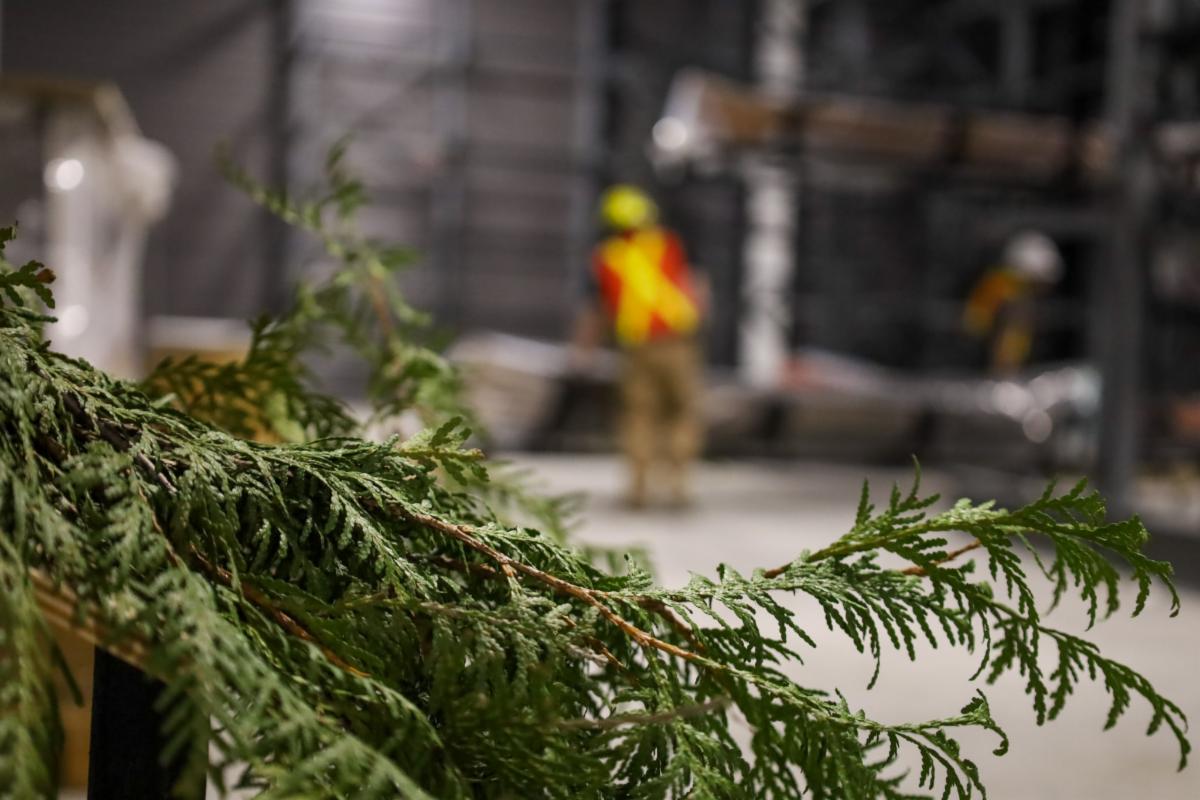
Traditional Care of Collections
The Canadian Canoe Museum recognizes that the care and preservation of cultural belongings goes beyond physical conservation outlined in the Canadian Conservation Institute’s ‘Agents of Deterioration‘. The Museum works to decolonize collections care and stewardship by welcoming ceremonial practices within the collection.
This may include, but not be limited to, smudging, food burning, or other protocols and ceremonies as defined by the source community relating to a cultural object or belonging within The Canadian Canoe Museum’s care.
The Knowledge and Research Centre
The Knowledge and Research Centre is home to the Archives Storage and the Library and Research Rooms. The Centre provides space for properly caring for a growing collection of rare books, maps and other archival assets, including film and video, photographs and recorded oral histories. The Knowledge and Research Centre also provides a comfortable and quiet environment for the recorded documentation of oral histories.
To request access to our library or archival collection or otherwise make use of this space, please connect with our curatorial team.
Contact Our Curatorial Team